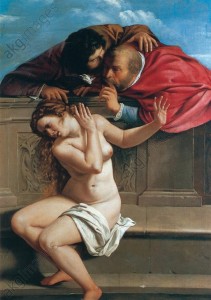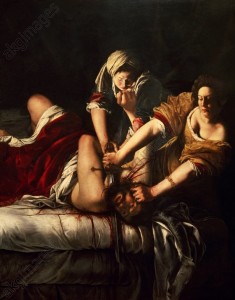Focus on art – Susannah and the Elders
I was listening to an interesting interview the other day about the lack of women artists in major museums and galleries. While this is not new to me, I had never really considered the fact that we are missing out on the female artist’s point of view in the history of art. One of the paintings the interviewee focussed on is Artemisia Gentileschi’s painting of “Susannah and the Elders”, a topic much favoured in the history of religious art.
Looking at a selection of images on this subject, all by male artists, it became very clear that Gentileschi’s painting has a very different focus to those of her male counterparts. Susannah is often depicted as colluding in the male gaze of the two elders; she is often seen preening herself, slightly coyly at times but often in provocative manner as if she were inviting the attention of the two men.
The most obvious of these types of depictions are Tintoretto’s paintings from 1550 and 1557 respectively. In the 1550 version we see Susannah being attended two by two women, one combing her hair and the other tending to her feet while Susannah herself is looking out at the viewer, inviting us to look at her. In the painting from 1557 Susannah is looking at herself in the mirror, her legs slightly apart, admiring herself.
The most clearly seductive image I found was painted by Franz von Stuck in 1904 – Susannah is seen here hiding behind a towel but peering straight at the two men, a strange form of striptease as if she were on a stage. Many of the other depictions I found in the archive show Susannah as a strangely passive victim, who may look slightly distressed but always seems a helpless victim of uninvited attention. Examples of this can be seen in the canvasses of Domenichino and Rubens, both painted in the early 17th century.
Gentileschi’s Susannah is a very different woman: she twists away from the lecherous men behind her, her body is contorted in obvious discomfort and her face is distorted in disgust. We can also recall Gentileschi’s brutal depiction of Judith decapitating Holofernes, painted in 1620, 10 years after Susannah and the Elders.

Gentileschi herself had been raped by her teacher, a friend of her father’s, Agostino Tassi. Her father brought a lawsuit against him for the rape in 1612, after she had finished Susannah but before Judith and we can see a definite progression in Artemisia’s rage against the biblical male protagonists.

In these two paintings by a famous female painter alone we can see that the thesis of a missing history in art is probably right. We are missing out on the female point of view and although art history has moved forward and is trying to give women artists a voice, we have a long way to go. Most of us will still think of the artist as male, often the tortured genius, working feverishly in his studio, on his own, even if there is much evidence to the contrary.




